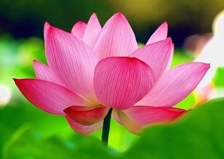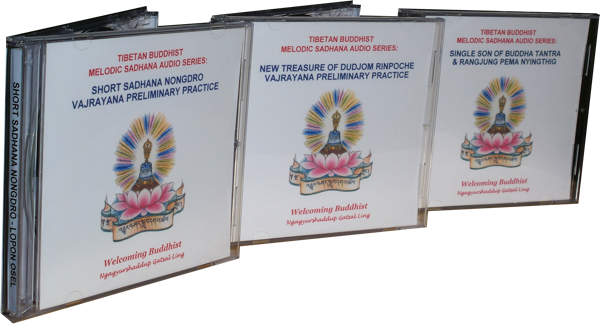Resources
Donations are Welcome
"Sharing the Merit, even if they give just one cent, people should have the motivation of putting a drop of water in the ocean. A drop of water on its own will easily evaporate, but in the ocean it will always remain." There are many ways you can contribute to WelcomingBuddhist for our future plans.
Calendar
- November 11, 2025
-
- November 14, 2025
-
-
Dakini Day - All day
-
Search
To not become happy because of praise, To not become unhappy because of blame, To support one's own good virtues, This is the character of the supreme being.
If the intention is good, the levels and paths are good. If the intention is bad, the levels and paths are bad, Since everything depends on intentions it is important that we make them positive.
Do not do anything harmful to one another, do only what is good. Discipline your own mind to subdue negative emotions.
Do no evil whatsoever, practice virtue perfectly, tame your mind completely. This is the teaching of the Buddhist doctrine.
-

Author Archives: Ven. Lopon Osel
The Barbarian
BUDDHIST TERMINOLOGY: THE BARBARIAN
In terms of secular western thinking, the word “barbarian” often conjures images of a cruel, brutish, merciless savage who, armed with a club or other means of violence, is intent on wreaking havoc. At the least, the word is associated with a person who may be from an undeveloped, uneducated area or country and regarded as lowbrow, crude, and vulgar.
However, in the Buddhist lexicon, the meaning of “barbarian” signifies something quite different. Rather than a person with sights set upon inflicting mayhem, the Buddhist term is more akin to what westerners think of as a “heathen”, hedonist or non-believer. It refers to “jungle mentality”, one who has the body of a human but the limited view of a jungle animal. Continue reading
COMING HOME – the cremation of Khandro Lhamo
Kyabje Dilgo Khyentse Rinpoche, was a distinguished teacher, of among others the Dalai Lama. He has been reincarnated as the Yangsi or ‘newborn’. The young Yangsi is one of the leaders presiding over the cremation of Khandro Lhamo, who in his past life had been his sang yum.
We see the extensive and colorful cremation, presided over by the most distinguished leaders of various Tibetan schools, partly because Khandro Lhamo was the Sang yum of Dilgo Khyentse Rinpoche, head of the Nyingmapas.
It may well be one of the last times the leaders of a Tibetan Buddhist cremation were actually born in Tibet. The importance of direct transmission during the rituals on to the new generation is therefore given extra weight by this cremation. Trulchik Rinpoche, Dzongsar Khyentse Rinpoche, Tenga Rinpoche, Yangsi, Neten Choling, as well as daughter Semo Chime Wangmo and Shechen Rabjam Rinpoche share their views. Continue reading
Short Sadhana Nongdro CDs now available
 Nongdro is the essential training of the Longchen Nyingthig tradition of the Nyingma lineage. Althoug Nongdro literally means “preliminary practice”, it is the foundation of all practices: the sadhana is a complete path in itself, conclusively leading us to the highest goal.
Nongdro is the essential training of the Longchen Nyingthig tradition of the Nyingma lineage. Althoug Nongdro literally means “preliminary practice”, it is the foundation of all practices: the sadhana is a complete path in itself, conclusively leading us to the highest goal.
Authentic Buddhist melodic sadhanas emanate from enlightened lineage masters, without the contamination of self-created ideas of the ordinary or negative minded. They carry the power of true Blessing. Those created by ordinary minds have neither real power nor blessing: they are like the imagined alluring sounds of a cascading waterfall falling upon deaf ears. We are happy to send these CDs. Please contact us so that we can provide them to you.
All the sadhanas listed on this website will be coming soon on CD.
These are available for a donation. Please click this link to learn more. Continue reading
Heart Treasure of the Enlightened Ones Teachings.
At Highland High School Salt Lake City. Teaching Beginning Jan 23- 2013 and going through mrach 6 end. Tibetan Buddhist An introduction, philosophy and meditation is the ancient science of developing the positive mind of wisdom; wisdom is purity and true happiness.
Ven. Lopon Osel, Professor of Tibetan Buddhist Philosophy and Meditation. The teaching of Buddhist view, meditation and action is one of the most profound because sentient beings have eighty-four thousand types of negative emotions.
There fore, the Buddha taught eighty-four thousand antidotes to these negative emotions. The book used in class is,“The Heart Treasure of the Enlightened Ones” commentary by H.H.Dilgo Khyentse Rinpoche (available at amazon.com) is a key to the Buddha’s teachings. If we don’t learn to practice love andcompassion, our negative emotions increase, leading to suffering. This class (session II) is a continuation of Fall Session I. Continue reading
Nagarjuna’s Letter to a Friend
Nagarjuna’s letter of advice to a king, outlining the main points of the Mahayana Buddhist path. [audio src="https://welcomingbuddhist.org/wp-content/uploads/2012/06/NagarjunaLetterToFriend.mp3"]
Teaching given by Lama Osel on June 12, 2012.
An Introduction to the Bardo
By Dudjom Rinpoche
A Talk Given on the Occasion of the Empowerment of the Thousand Buddhas Associated with the Sadhana of the Noble Compassionate One, the Lord of Space It has been said that the whole of the Buddha’s doctrine could be summarized in the teaching on the six bardos.
The Buddhadharma is vast and profound, and the many approaches of the various vehicles and cycles of teaching comprise an inconceivable wealth of instruction.
For those who wish to attain the primordial citadel of Buddhahood in the course of a single human life, the practice of these teachings is presented within the framework of the six bardos.
What, therefore, is a bardo? A bardo is a state that is “neither here nor there”: by definition it is something that comes “in between,” an intermediate state. The six bardos are:
- the natural bardo of the present life
- the hallucinatory bardo of dreaming
- the bardo of meditative absorption
- the painful bardo of dying
- the luminous bardo of ultimate reality
- the karmic bardo of becoming
Seven Points of Mind Training at University of Utah
The Seven Points of Mind Training tuedays 6-to 8 pm. Kadampa Master Geshe Chekapa Beginning October 16 and going through November 13 end. Mind training means how to develop bodhicitta. This introductory course and practice for mind training is to foster compassion and love to all motherly sentient beings. If we don’t learn this basic practice then our loving compassion is like a summer rainbow, it appears but suddenly disappears. Continue reading
Teachings on the Bardos given by H.H.Dudjom Rinpoche
This was provided by Rinpoche teaching, California in 1980.
First is the bardo of birth and life; second, the bardo of meditation; third, the bardo of dreaming; fourth, the bardo of death and dying; fifth, the bardo of the true nature; and sixth, the bardo of becoming.
These six can be abridged to four: the bardo of birth
and life, the bardo of death and dying, the bardo of true nature,
and the bardo of becoming. Of these four the bardo of birth and
life is most important because right now we all have a precious
human birth with the eighteen endowments.
We have available
to us teachers who are to a certain degree well qualified, and the
teaching we receive is a wish-fulfilling jewel, the very precious
teaching of the sutras and tantras. It is rare to have such a precious opportunity. Don’t waste your timewhen you have everything going for you. Continue reading
Heart Treasure of the Enlightened Ones Teachings
This book is an explanation of the Buddhas teaching, like a key. The teaching in the text is one of the most profound and extensive because sentient Beings have eighty four thousand types of negative emotions. Therefore the Buddha taught eighty four thousand antidotes to these negative emotions. If people don’t have a loving compassion practice, their negative emotions always increase. The result is suffering. We will be using the text: The Heart Treasure of the Enlightened Ones: available on the internet. This class will be at Highland High School in Salt Lake City. Buddhist Philosophy and Meditation will also be a part of this class.
The class will start on September 12, 2012. More information about this class will be available on the calendar.
Continue reading
Dzogchen View of tantric Ngöndro:
A teaching by His Holiness Dudjom Rinpoche, First Supreme Head of the Nyingma School in exile from Tibet; augmented by replies to questions asked by Ngak’chang Rinpoche in private audiences, relating to the short Düd’jom gTérsar ngöndro, Bodhanath, Kathmandu, Nepal, 1979.
Whatever the practice in which we engage, relative truth and absolute truth are co-existent. Method and wisdom are co-existent. Experiences and emptiness are co-existent. Because this is the nature of the reality we experience, the practice of tantric ngöndro exists as a method for realising the beginningless enlightened state.
Continue reading

